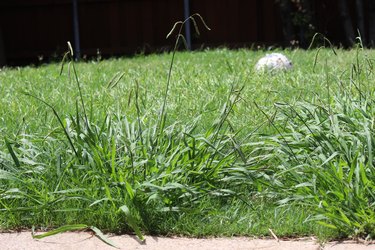
2,4-dichlorophenoxyacetic acid, otherwise known as 2,4-D is a herbicide that's been around since 1945. Over time, it's gained a reputation as one of the most powerful tools in the constant battle against weeds in gardens, crop fields and pastures. And though it doesn't work against every type of weed, it is a useful tool for an avid gardener or farmer looking to get rid of pesky plants that may hurt their crops.
2,4-D Uses
Video of the Day
The herbicide 2,4-D is designed to kill broad-leaf weeds, which include common lawn weeds such as dandelions and clovers. However, because the herbicide must kill these common weeds without harming the lawn or landscape to be useful, it is formulated to have no effect on grass species. While crabgrass can take over a lawn and cause serious troubles for a landscaper, it is still a type of grass and is therefore unaffected by the chemical powers of 2,4-D.
Video of the Day
What Is Crabgrass?
While it may look like other types of grass at first glance, crabgrass gets its name from its distinctive spread, which starts at a central stem or root and sprouts blades that resemble a crowd. The grass is coarse and generally takes on a lighter green color than many other grasses. The grass sprouts in a matter of weeks and spreads by dropping its seeds each fall, ensuring that it will invade the same area next year.
Crabgrass thrives in hot, dry weather, which is generally the time that other species of grass are struggling for survival. The quick spread and fast growth of crabgrass allows it to quickly choke out other grasses, absorbing all of the water and nutrients from the soil and leaving other species to struggle and die.
Crabgrass Herbicides
While 2,4-D doesn't work on crabgrass, there are a number of herbicides that will. If you know you have a crabgrass problem, apply a pre-emergent herbicide containing fenoxaprop, benefin or bensulide in early spring, before seeds begin to appear and sprout. If the crabgrass has already taken hold or it is too late for a pre-emergent chemical treatment, use a product containing quinclorac, which is available for homeowner use at garden centers and nurseries; follow all instructions and warnings carefully.
Crabgrass Lawn Treatment
Keep your grass mowed higher than the general recommendation for your species; if you are unsure, keep it higher than 3 inches. Higher grass will shade the weeds and keep the soil cool. Remember that crabgrass grows in hot, dry areas. Water your lawn to a depth of 4 to 6 inches but only once every week and a half to two weeks, depending on your climate and soil. If you water shallowly and often, you are allowing the weed seeds constant access to moisture. Fertilize only in the early spring and late fall, when the grass can take advantage of the food but the weeds cannot.
Some Precautions
The toxicity of 2,4-D isn't too bad for humans or animals if they aren't exposed to a lot of it it over a long period of time. That being said, anyone using 2,4-D should be cautious that it doesn't get into their eyes or that they don't ingest it. Avoid touching the plant or the area around it until the herbicide is completely dry. If you have any pets that are allowed outside, keep them inside of your home until you are sure that the plant you sprayed isn't wet any more.